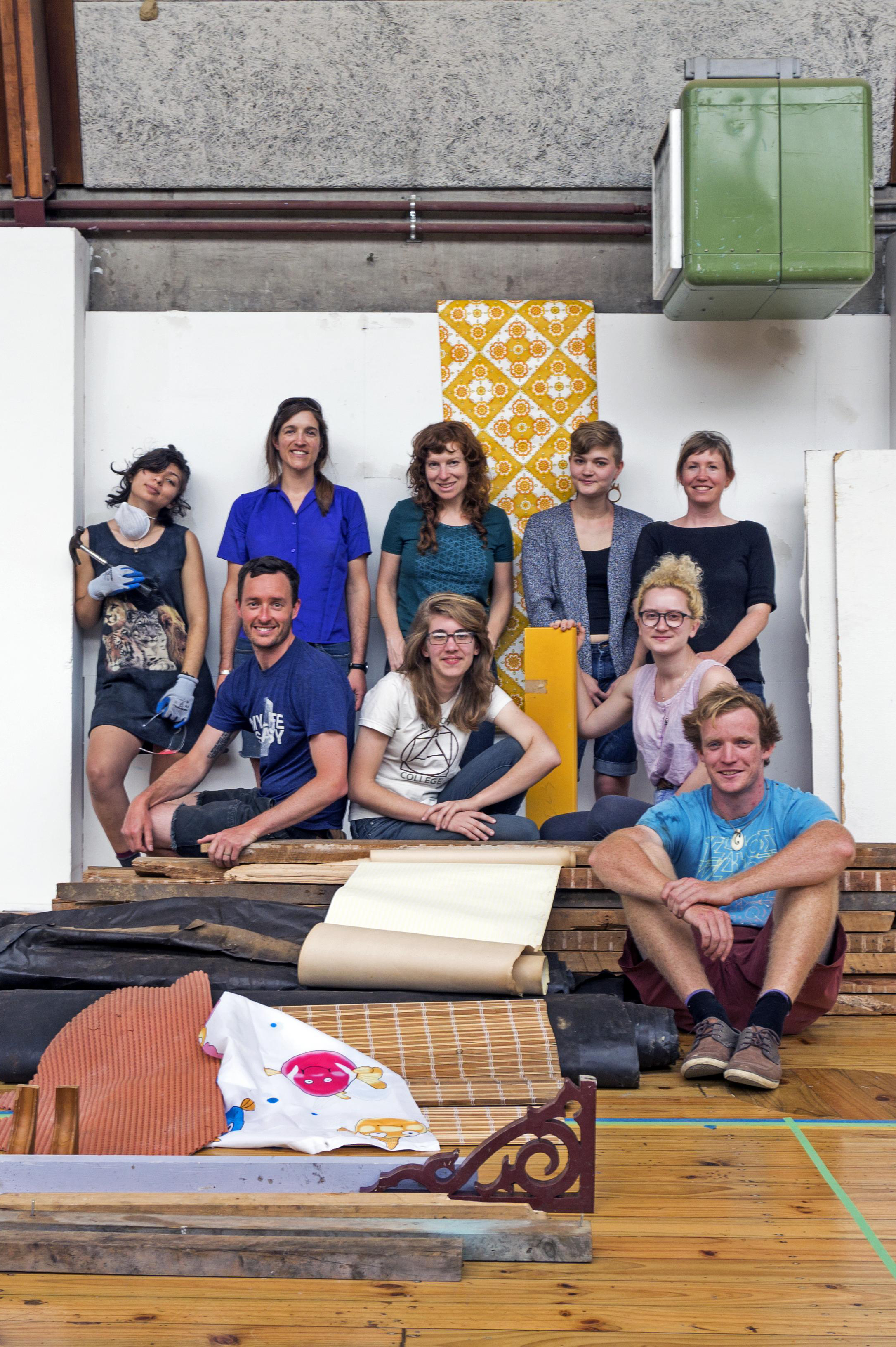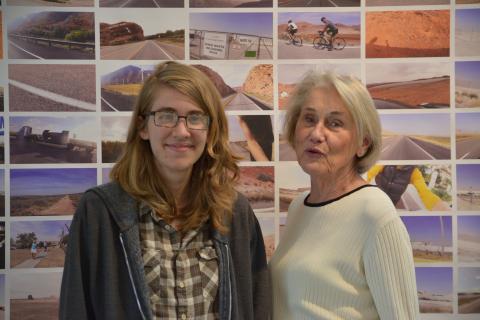Humanize not Militarize: Foreman ’17 at American Friends Service Committee (AFSC) in Chicago, Illinois
Feb 09, 2016For my third co-op, I’m working as the Humanize not Militarize intern in the Chicago office of the American Friends Service Committee (AFSC). AFSC, “a Quaker organization that promotes lasting peace with justice…nurtur[ing] the seeds of change and respect for human life that transform social relations and systems,” has tons of national and international offices and programs, including a couple of separate programs run out of the Chicago office, and I’m working specifically under the umbrella of the Wage Peace campaign. My primary role is to provide project support for Humanize not Militarize, a traveling poster exhibit and youth film festival that examine the effects of militarism at both the foreign and domestic policy levels. Though it has many components, the project, broadly, asks one crucial question: how do we demilitarize society?
Because Humanize not Militarize has such a wide focus, I get to do a variety of tasks covering a broad scope of issues. Recently, I’ve been working on writing and designing a small booklet–what you’d call a zine if you weren’t working at a hundred year old Nobel Peace Prize-winning nonprofit–that explores the history and current focal points of the four main issues explored in the poster exhibit, linking policy agendas to an understanding of militarism. Those four main issues–policing, prisons, war, and borders–are nowhere near separate from each other, and the booklet I’m in the process of finishing makes a point to emphasize that.
Outside of the office, my coworkers and I attend various rallies and marches in downtown Chicago every week, and sometimes multiple times per week. Tonight, I went to the Chicago Teachers Union’s rally in Grant Park. Earlier today, I went to a press conference organized by Faith in Public Life urging Gov. Rauner to welcome Syrian refugees, reversing his earlier statement to make refugee resettlement harder at every turn. My boss (or really, my boss’s boss), Rabbi Brant Rosen, along with faith leaders from across the city, gave statements explaining why their faith traditions implore them to support refugees wherever and whenever possible.
It’s refreshing to work in a place with firmly-held and explicitly-stated beliefs. The most rewarding part of my co-op so far, however, has been working with 13 and 14 year old “gap year” students from Village Leadership Academy who are interning with Wage Peace three mornings a week. They work with us from nine to noon on Tuesdays, Wednesdays, and Thursdays, in an intermediary program between 8th and 9th grade–it’s a little like they’re on co-op too. Lately, we together developed a “militarism scavenger hunt” throughout downtown Chicago to add to the Humanize not Militarize curriculum, read portions of Against All Odds: Voices of Popular Struggle in Iraq, and did a brief photoshop tutorial to prepare them to design solidarity posters in the wake of Spike Lee’s controversial “Chi-Raq.”
In October, we took some of the exhibit posters to a press conference outside of U.S. Immigration and Customs Enforcement’s Chicago headquarters, which, incidentally, is three blocks from the office and right where I get off the train every morning. My fellow (though much younger) interns Jakya and Alex’s reflections on the experience, and acute insight into the human side of immigration debates, made for great conversation afterwards. It’s not the global scope of AFSC’s advocacy that makes showing up to work every day exciting, though that’s nice too, but working with young people who are already incredibly insightful and dedicated to justice. I get mass emails every day outlining high-profile places where AFSC’s work is being covered, like this piece in The Nation, but overall, I’ve come to realize that while mission does matter, often it’s the interpersonal character of organizations that drives people to work hard and provide support for their peers. As I return to Antioch in the winter, I’ll make sure not to forget the people I’ve met in Chicago and the crucial work they continue to support.
How the Past Contributes to Visions for the Future: Foreman ’17 at Whole House Reuse in Christchurch, New Zealand
Feb 09, 2016This quarter, Selena Wilkinson ’17 and I are working for the Whole House Reuse project in Christchurch, New Zealand. Whole House Reuse, a project facilitated by Rekindle, aims to make visible the amount of waste occurring throughout the Canterbury region as buildings are demolished and rebuilt after Christchurch’s now-famous earthquakes of 2010 and 2011. How is Whole House Reuse making waste visible? The project’s goal is to transform an entire home–including not just its now-rare native New Zealand timbers but also its electrical fixings, carpeting and underlay, kitchen components, and everything else–in the post-earthquake “red zone” into functional objects, diverting these materials from landfill in a positive way.
Though earthquakes were once unusual on New Zealand’s South Island, Christchurch’s recent past is dotted with earthquakes varying in intensity, many of which are aftershocks of a September 2010 quake that resulted in the “strongest earthquake ground-shaking ever recorded in New Zealand.” [source] This September 2010 quake had a magnitude of 7.1–higher than the magnitude of the following quakes, but less destructive than the earthquakes to come as it struck at night when people were asleep and its epicenter was located outside of the city proper. The most destructive of the aftershocks was a February 2011 earthquake, which, with a magnitude of 6.3 and an epicenter within Christchurch’s southeastern suburbs, caused at least 181 deaths. Many smaller aftershocks followed this earthquake, including a notable June 2011 earthquake, but none as devastating as the February quake, which resulted in the later demolition of 70% the city center.
With 70% of the city center demolished and entire neighborhoods designated as “residential red zones” owned by the crown and deemed unsuitable for housing, the city’s future is a frequent topic of conversation. New housing is popping up everywhere, with few reminders of the past. With everything headed straight to landfill, this lack of visual memory–outside of the ever-present safety cone, of course–is easy to understand. However, even strategic reuse can still result in a loss of history and memory, and it’s crucial that we put in an effort to value materials and the life they once had when thinking about their future, in both Christchurch and Yellow Springs.
At Antioch, the rapid pace and transitions of academic and work quarters combined with the busy growth of the institution often leads to conversations where we’re all trying to figure out how things were done last year, or even last term. As we demolish decrepit buildings and rebuild the physical and institutional infrastructure of a college, it’s important that we take care to consider what we want our future to be. In the vein of both Whole House Reuse and the Mills Hall Project, we can endeavor to include the past in our visions of the future and use community history and memory not just for nostalgic value, but for understanding and solving the problems we face today. A big part of this is community building in the form of participatory research. As we consider which material to re-use and re-purpose, we can always make room for more perspectives–as I’ve learned at Whole House Reuse, people are often able to create something of value from material that, on the surface, seems to have no use left.
Addressing the Pressing Social Issues of Our Time: Foreman ’17 at Santa Fe Arts Institute in Santa Fe, New Mexico
Feb 08, 2016Pictured is Jane Foreman, ’17, working at the Santa Fe Art Institute (SFAI). She is pictured here with Antioch College Trustee Joyce Idema ’57, who is also president of the board at SFAI.
This spring I’m living and working at the Santa Fe Art Institute, a non-profit arts organization in Santa Fe, NM whose mission statement asks a critical question: “How can SFAI cultivate creative practices (from fine art to design to urban planning and beyond), engage with diverse communities and address the most pressing social issues of our time?” The two primary organs of SFAI that do this are the residency program, through year-long thematic residency cycles that “address pertinent questions facing diverse local and global communities,” and the education program, which consists of a large range of educational efforts from extended workshops within incarceration facilities to traveling exhibitions. My place within SFAI falls somewhere between these two departments.
As the Special Projects Associate, I work on projects that don’t fit firmly in either the residency program or the education program or lie completely outside of them. Right now, my primary work is developing an art lending program. This program, called SFAI Works: Art Loan, aims to increase meaningful and educational access to contemporary art in Northern New Mexico though a collection of mobile art crates packed with anywhere from four to twelve pieces of original art created by past artists in residence at SFAI. What’s been exciting for me so far is the wide range of work required to get the art loan program running. Since I arrived in April, I’ve done everything from photographing and cataloging art to writing loan agreements and contracts to contacting organizations about the possibility of hosting one of our art crates.
What’s great about working at SFAI is the opportunity to assist artists and organizations who are doing the same type of work that I read about in my classes. SFAI as an institution is relentlessly bent on social practice, and by working here I not only get to interact with amazing people working to creatively solve critical social problems, I get to help them do it. It’s one thing to be in political economy class researching and analyzing the ways urban design is impacted by economics, but it’s something totally different to be concretely supporting the work done by design activists and teachers, like those involved in SFAI’s Design Workshop this summer, to use design itself to shift social realities.
The picture of me in this post is with Joyce Idema, ’57. Joyce is president of the board at SFAI and an Antioch College Trustee. We are pictured in the SFAI gallery. The work that we’re standing in front of is part of a traveling project by Smudge Studio called Look Only At The Movement, which examines the present and asks questions about the future of humanity’s relationship with nuclear waste.
I’ve learned a lot about the dismal state of nuclear waste disposal through this exhibition, which draws attention to the very pressing design issues involved in the increasingly relevant search for safe disposal methods for leftover radioactive material, as we currently have no solution. In all, I’m very glad to be able to take part in the innovative work that SFAI is doing to support and promote the work of people like Jamie Kruse and Elizabeth Ellsworth of smudge studio, as it provides a great opportunity to see the ways that my frequently-abstract studies are physically and concretely explored and manifested.




